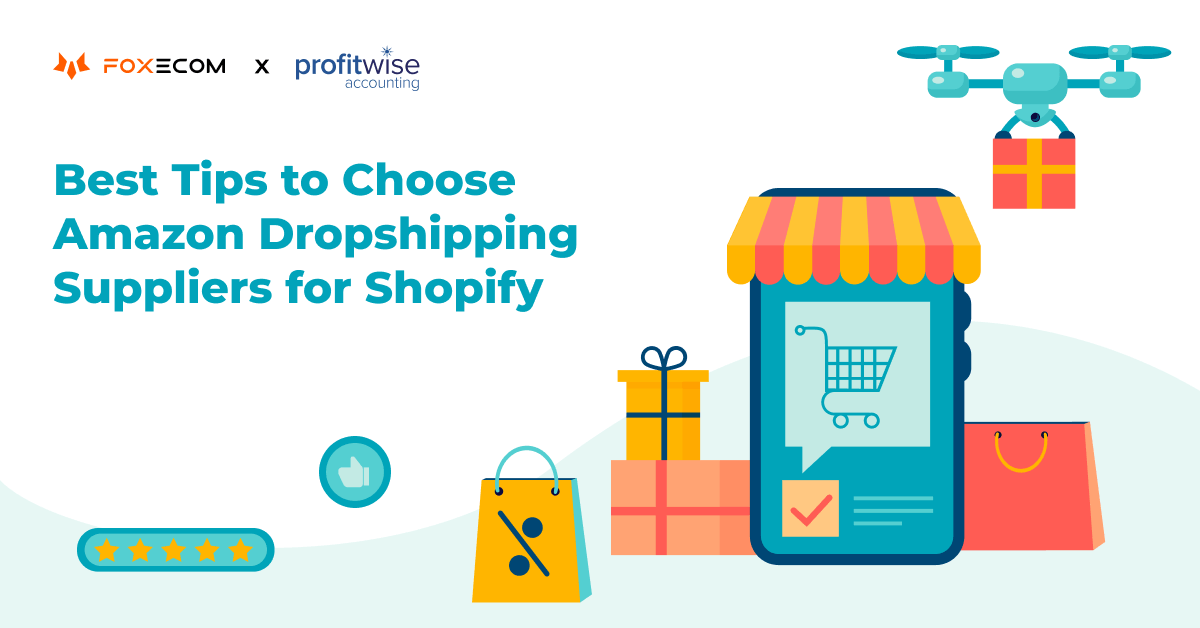If you're stepping into the world of eCommerce or looking to expand your existing online business, you're in the right place! This blog will walk you through everything - from why Amazon is an excellent choice for dropshipping and how to find reliable Amazon dropshipping suppliers, to navigating through Amazon's policies, and more. We've got everything covered, so let's dive right in!
Why Choose Amazon as Your Dropshipping Supplier?
With 34% of orders on Amazon from dropshipping, choosing Amazon dropshipping is a great move, especially if you're just starting out in eCommerce.
You don't need to buy and store a bunch of products in advance. This means you can say goodbye to those hefty costs for rent, utilities, and salaries before you even make your first sale.
Image source: Dropshipping.com
With Amazon dropshipping, the cost of kicking off your business is way lower. You only need an Amazon seller account and trusted Amazon dropshipping suppliers.
Plus, you're not taking a big risk by buying a lot of stock upfront. You only order products when customers buy from you, so you're not stuck with items you can't sell.
Another cool thing is that you can make lots of money on Shopify by selling your products not just on Amazon but on your own website and other marketplaces too. This opens up many opportunities to reach customers and grow your business.
Amazon dropshipping also makes it easy to try out new products and see what your customers like best without the risk of overstocking. It's a flexible, low-risk way to expand your eCommerce business or get started.
Finding the Right Amazon Dropshipping Suppliers
Look for Amazon dropshipping suppliers who are reliable and trusted.
According to the most recent Shopify update, you should focus on Amazon dropshipping suppliers who offer transparency about their manufacturing process, have clear communication channels, and provide fair payment and production terms.
Here are some tips to find trustworthy Amazon dropshipping suppliers:
Check their ratings and reviews. You’ll want Amazon dropshipping suppliers with good reviews because it means they're reliable and their products are good. This helps you avoid bad surprises.
Image source: Lydio KOH (via LinkedIn)
Utilize online resources and directories such as Alibaba, ThomasNet, and Maker's Row. Don't forget to leverage personal networks for potential leads.
Ask for referrals, and consider both domestic and international options. It's wise to order samples before committing to large orders and to ensure they have acceptable minimum order quantities (MOQs) that match your business needs.
Also, see if they offer Prime shipping. Amazon dropshipping suppliers that use Prime are usually more experienced with shipping quickly.
Finally, contact the Amazon dropshipping suppliers. Send them a message saying you're interested in dropshipping their products. Ask any questions you have, like about returns or how fast they ship. Just remember to request samples to ensure quality.
Want to discover more? Check these frequently asked questions of Amazon suppliers.
Finding the right Amazon dropshipping suppliers takes a little bit of work, but it's definitely worth it.
Integrating Amazon Dropshipping Suppliers with Your Shopify Store
This might initially seem tricky, but once you know the steps, it clicks! Here's how to do it.
First, you need to set up your Shopify store. Once it's ready, you're set to connect with Amazon suppliers.
Now, find a tool or app that helps connect Amazon to Shopify. Be sure to check Amazon Integration Plus first, as it's designed specifically to seamlessly link your Amazon products with your Shopify store. Other solid options are Zonify and Amazon Importer Spreadr App.

Image source: Shopify App Store
Next, using the chosen tool, search for products from your Amazon dropshipping suppliers. Once you find products you like, the tool will let you add them to your Shopify store with just a few clicks.
Finally, make sure everything looks good in your Shopify store. Check product details, prices, and images. You want everything to be perfect for your customers.
To doll up your Shopify store, consider using a convenient tool like Foxify - Smart Page Builder. It offers 90+ stunning and high-converting templates of all niches and page types, with built-in upsell and cross-sell extensions to save you hundreds of dollars from using extra third-party apps.

Understanding Amazon's Dropshipping Policies
Understanding Amazon's dropshipping policies is crucial. Here's what you need to know, plain and simple.
- You must be the seller: Even though you're using Amazon to supply products, you need to be listed as the seller on all packing slips and invoices.
- No double-dipping: You can't buy products from another online retailer and dispatch them directly to your customers. That's a no-go.
- Your info, not Amazon's: All packaging that you send to your customers must not have Amazon branding. It should look like it's coming from you, not Amazon.
- Stay responsible: If an order is late or damaged, it's on you. You need to take care of your customers and solve any issues.
- Be clear about returns: Make sure your customers know how to return products and that you have a clear return policy in place.

Image source: Amazon
Following these rules keeps things smooth between you, Amazon, and your customers. It's all about ensuring everyone knows who's selling the product and keeping customers satisfied.
Optimizing Your Product Listings for Maximum Visibility
Think of your product listings like billboards. You want them to catch people's attention and tell them exactly what they're getting.
First, think about keywords. These are words people might type into a search bar to find your product. Include them in your title and description, but keep it natural. You're not just trying to please the search engines, you're talking to real people.
Continue with a catchy title that clearly says what the product is. Include important details like color, size, or brand, so it pops up in searches.

Image source: Unsplash
Next, your description is where you get to tell a little story about your product. Why is it amazing? How can it make your customer's life better? Keep it fun and friendly, like you're talking to a friend.
Photos are super important, too. Use bright, clear pictures that show off your product from different angles. If you can, show it in action. People love to imagine what it would be like to have your product in their hands.
Want to dive deeper? Check this 101 guide on product listing optimization.
By making your listings clear, attractive, and easy to find, you're opening the door to more visitors and, hopefully, more sales.
Navigating Financial Challenges in Amazon Dropshipping
The first thing you need to pay attention to is your costs, including the price of goods, Amazon fees, and shipping expenses. These can quickly add up, and if you're not careful, they can take a big bite out of your profits.
Another challenge is managing your cash flow. Sometimes, there can be a delay between paying your Amazon dropshipping suppliers and receiving payment from your customers. This can make it tricky to keep everything running smoothly without facing financial difficulties.
To prevent these issues, you must keep a close eye on your expenses and sales. Tools and apps designed to follow these numbers can be a big help. Creating a budget and sticking to it can also keep you on track.
Managing all of this on your own can be overwhelming, especially when it comes to more complex issues like taxes. That's where consulting with an expert in Amazon seller accounting comes in handy, as they can assist with identifying tax-deductible expenses and optimizing your financial strategy.
By working with someone who knows the specifics of Amazon accounting, you can focus more on growing your business and less on financial burdens. This is a sure way to stay compliant and avoid any legal issues.
Pricing Strategies for Your Dropshipped Products
Setting the right price for your dropshipped products is vital. So, let's explore some smart pricing strategies that can help increase your sales and expand your business.
Know Your Costs
Your costs include everything from what you pay for the product to any shipping fees and even Amazon fees if you're getting your products from Amazon dropshipping suppliers.
Once you've figured out all your costs, you can decide how much to charge for your items. The goal is to find that perfect spot where you're making a good profit, but your prices are still great for your customers.
Use Psychological Pricing Techniques
Have you ever wondered why prices at stores often end in “.99” instead of rounding up to the nearest dollar? There's a trick to it, and it's all about how our brains see prices.
For example, when you see something priced at $19.99 instead of $20, your brain thinks it's a better deal, even though the difference is just a penny. This is called psychological pricing, and it's a smart way to make your products more appealing.
Using psychological pricing can help your dropshipped products stand out. It's like when you're more likely to buy a snack for $1.99 rather than $2. Setting prices just below a whole number can make customers more interested in buying.

Image source: Lightspeed
So, when you're deciding how to price your products, consider using numbers like .99, .95, or .49 at the end. It's a simple change that can make a big difference.
Adapt to Market Changes
According to American Express research about market adaptation strategies, you should actively monitor your competitive environment, like tracking competitor pricing or shifts in product demand, to adjust your strategies effectively.
If lots of stores start selling the same thing you are, you might need to lower your price a little to stay competitive. Or, if a product becomes super popular and everyone wants it, you might be able to charge a bit more. It's all about balance, so stay flexible and updated.
Analyze the Competition
In dropshipping, analyzing your competition means checking out what other stores are charging for products similar to yours. You'll see how they present their products and at what price so you can figure out how to make your store stand out.
It's pretty simple to do. Just search for the products you're selling on Amazon and see what prices pop up. Look at a few different sellers to get a good idea of the average price.
Check out their customer reviews and see what people say about their prices and products. This can give you clues on how to price your own items.
If everyone else is selling a product for $20, maybe you decide to sell it for $19.75. It's just a little less, but it might be enough to make shoppers choose your store.
And there you have it! We hope we helped you better understand how to navigate the world of Amazon dropshipping for your Shopify store. Remember, the key is to be informed, adaptable, and always ready to learn and grow. We wish you the best of luck!






